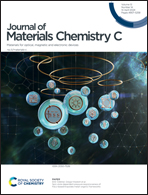Tailoring quantum transport efficiency in molecular junctions via doping of graphene electrodes†
Abstract
The efficiency of charge transport across a molecular bridge, such as a self-assembled monolayer (SAM), in molecular electronics is influenced not only by the molecules’ structural configuration but also significantly by the choice of electrode materials. Single-layered graphene (SLG), a novel electrode material, offers unique benefits for forming such junctions, including exceptional flexibility, high transparency, and elevated carrier mobility. Notably, the work function of SLG can be modulated through p-type or n-type doping. In this study, we used our previously reported micro-well devices to fabricate Au/SAM/SLG junctions. Two types of SAMs were employed: one forming a HOMO-dominated junction, while the other formed a LUMO-dominated junction. These SAMs were coupled with three variants of chemical vapor deposited (CVD) SLG: as-transferred, n-type doped, and p-type doped, yielding six distinct combinations. Our results show that doping effectively adjusts the relative energetic position of the Fermi level between the graphene electrode and the molecular frontier orbitals, thereby controlling the quantum transport efficiency through the molecular bridge. These findings open new possibilities for designing high-performance molecular electronic devices such as biosensors, field-effect transistors, and thermoelectric harvesters.



 Please wait while we load your content...
Please wait while we load your content...